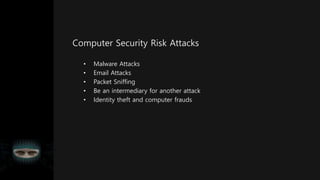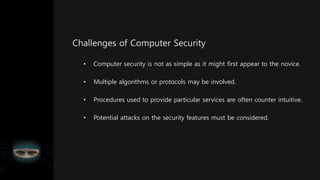Computer Security
- 2. • Computer Security is a security that is applied to computing devices for the protection of computing systems and the data that they store and access. • The network environments and network based applications provide more attack paths. • Computer administration and management have become more complex which produces more attack avenues.
- 3. Layers of Computer Security • Layer 01: Physical Security – Safeguard the personal, hardware, programs, networks and data from physical threats. • Layer 02: Network Security – Protects the networks and their services from unauthorized modification, destruction or disclosure. • Layer 03: System Security – Protects the system and it’s information from theft, corruption, unauthorized access or misuse. • Layer 04: Application Security – Cover the use of software, hardware and procedural methods to protect applications from external threats. • Layer 05: User Security – Ensure that a valid user is logged in and that user is allowed to use an application.
- 4. Key Objectives of Computer Security • Confidentiality – Assures that private or confidential information is not ma de available or disclosure to unauthorized individuals. • Integrity – Assures that information and programs are changed only in a specified and authorized manner and that system performs it’s intended fu nction in an unimpaired manner, free from deliberate. • Availability – Assures that systems work promptly and service is not denied to authorized users.
- 5. What to Secure In Computer Security ? • Hardware – Laptops, Desktop, PCs, CPU, Hard disk, Storage devices, etc. • Software – Operating System and Software Applications • Communications – Emails, Instant messengers and browsing activities. • Data – Personal identifications like Identity Numbers, Passwords, Credit Card details, etc.
- 6. Fundamental Concepts of Computer Security • Precaution – follow the preventive measures while using computer system and applications. • Maintenance – Managing all the challenges in computer applications and keep them up to date. • Reaction – Act timely when security incidents occur.
- 7. Computer Security Risk Attacks • Malware Attacks • Email Attacks • Packet Sniffing • Be an intermediary for another attack • Identity theft and computer frauds
- 8. Challenges of Computer Security • Computer security is not as simple as it might first appear to the novice. • Multiple algorithms or protocols may be involved. • Procedures used to provide particular services are often counter intuitive. • Potential attacks on the security features must be considered.
- 9. Benefits of Computer Security Awareness • This type of Awareness helps to minimize the chance of computer attacks. • It helps to protect sensitive information and computing resources from unauthorized access. • Helps to prevent loss of information in the system. • It used to protect from cyber criminals from using their systems in order to launch attacks on the other computer systems.








